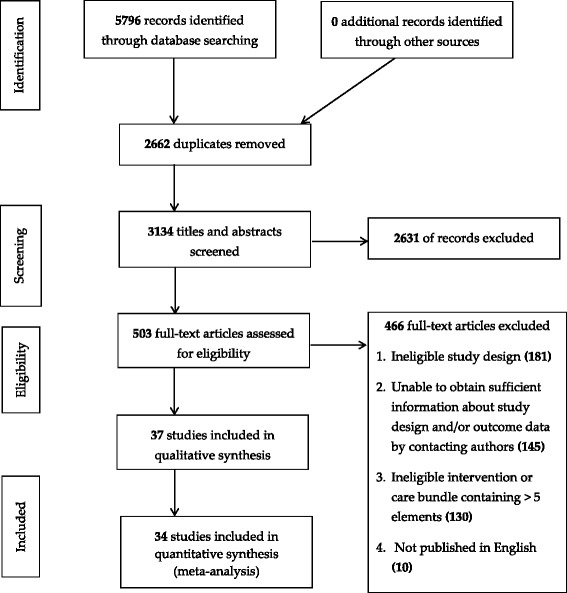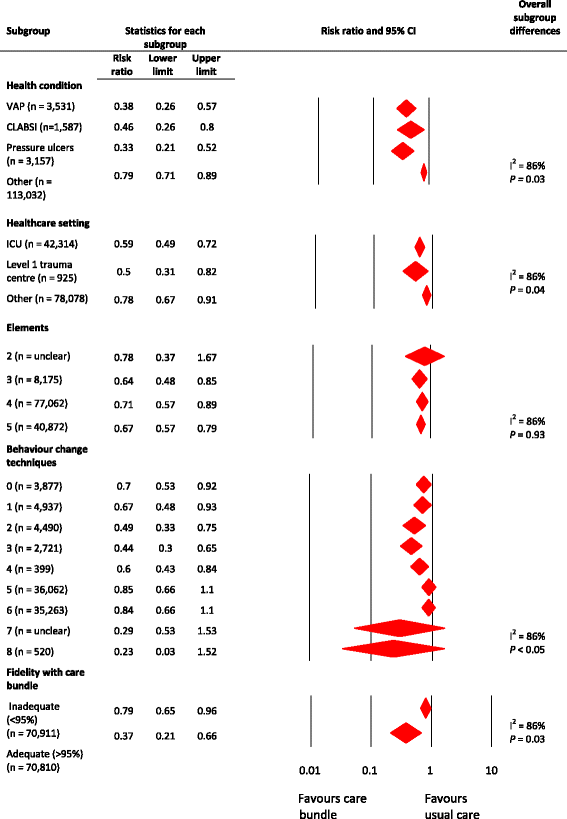The effects of care bundles on patient outcomes: a systematic review and meta-analysis
- PMID: 29187217
- PMCID: PMC5707820
- DOI: 10.1186/s13012-017-0670-0
The effects of care bundles on patient outcomes: a systematic review and meta-analysis
Abstract
Background: Care bundles are a set of three to five evidence-informed practices performed collectively and reliably to improve the quality of care. Care bundles are used widely across healthcare settings with the aim of preventing and managing different health conditions. This is the first systematic review designed to determine the effects of care bundles on patient outcomes and the behaviour of healthcare workers in relation to fidelity with care bundles.
Methods: This systematic review is reported in line with the PRISMA statement for reporting systematic reviews and meta-analyses. A total of 5796 abstracts were retrieved through a systematic search for articles published between January 1, 2001, to February 4, 2017, in the Cochrane Central Register for Controlled Trials, MEDLINE, EMBASE, British Nursing Index, CINAHL, PsychInfo, British Library, Conference Proceeding Citation Index, OpenGrey trials (including cluster-randomised trials) and non-randomised studies (comprising controlled before-after studies, interrupted time series, cohort studies) of care bundles for any health condition and any healthcare settings were considered. Following the removal of duplicated studies, two reviewers independently screen 3134 records. Three authors performed data extraction independently. We compared the care bundles with usual care to evaluate the effects of care bundles on the risk of negative patient outcomes. Random-effect models were used to further explore the effects of subgroups.
Results: In total, 37 studies (6 randomised trials, 31 controlled before-after studies) were eligible for inclusion. The effect of care bundles on patient outcomes is uncertain. For randomised trial data, the pooled relative risk of negative effects between care bundle and control groups was 0.97 [95% CI 0.71 to 1.34; 2049 participants]. The relative risk of negative patient outcomes from controlled before-after studies favoured the care bundle treated groups (0.66 [95% CI 0.59 to 0.75; 119,178 participants]). However, using GRADE, we assessed the certainty of all of the evidence to be very low (downgraded for risk of bias, inconsistency, indirectness).
Conclusions: Very low quality evidence from controlled before-after studies suggests that care bundles may reduce the risk of negative outcomes when compared with usual care. By contrast, the better quality evidence from six randomised trials is more uncertain.
Trial registration: PROSPERO, CRD42016033175.
Keywords: Behaviour change; Care bundle; Effectiveness; Implementation fidelity.
Conflict of interest statement
Ethics approval and consent to participate
Not applicable.
Consent for publication
Not applicable.
Competing interests
The authors declare that they have no competing interests.
Publisher’s Note
Springer Nature remains neutral with regard to jurisdictional claims in published maps and institutional affiliations.
Figures
Similar articles
-
Drugs for preventing postoperative nausea and vomiting in adults after general anaesthesia: a network meta-analysis.Cochrane Database Syst Rev. 2020 Oct 19;10(10):CD012859. doi: 10.1002/14651858.CD012859.pub2. Cochrane Database Syst Rev. 2020. PMID: 33075160 Free PMC article.
-
Non-pharmacological interventions for preventing delirium in hospitalised non-ICU patients.Cochrane Database Syst Rev. 2021 Jul 19;7(7):CD013307. doi: 10.1002/14651858.CD013307.pub2. Cochrane Database Syst Rev. 2021. PMID: 34280303 Free PMC article.
-
Systemic pharmacological treatments for chronic plaque psoriasis: a network meta-analysis.Cochrane Database Syst Rev. 2021 Apr 19;4(4):CD011535. doi: 10.1002/14651858.CD011535.pub4. Cochrane Database Syst Rev. 2021. Update in: Cochrane Database Syst Rev. 2022 May 23;5:CD011535. doi: 10.1002/14651858.CD011535.pub5. PMID: 33871055 Free PMC article. Updated.
-
Interventions to improve antibiotic prescribing practices for hospital inpatients.Cochrane Database Syst Rev. 2017 Feb 9;2(2):CD003543. doi: 10.1002/14651858.CD003543.pub4. Cochrane Database Syst Rev. 2017. PMID: 28178770 Free PMC article.
-
Negative pressure wound therapy for open traumatic wounds.Cochrane Database Syst Rev. 2018 Jul 3;7(7):CD012522. doi: 10.1002/14651858.CD012522.pub2. Cochrane Database Syst Rev. 2018. PMID: 29969521 Free PMC article.
Cited by
-
A multifaceted educational intervention improved anti-infectious measures but had no effect on mortality in patients with severe sepsis.Sci Rep. 2022 Mar 10;12(1):3925. doi: 10.1038/s41598-022-07915-9. Sci Rep. 2022. PMID: 35273276 Free PMC article.
-
The Impact of the Dialysis Event Prevention Bundle on the Reduction in Dialysis Event Rate in Patients with Catheters: A Retrospective and Prospective Cohort Study.Diseases. 2024 Nov 24;12(12):301. doi: 10.3390/diseases12120301. Diseases. 2024. PMID: 39727631 Free PMC article.
-
Effectiveness of Nursing Interventions on Preventing the Risk of Infection in Adult Inpatients: Protocol for a Systematic Review.Nurs Rep. 2025 Jun 11;15(6):210. doi: 10.3390/nursrep15060210. Nurs Rep. 2025. PMID: 40559501 Free PMC article.
-
Multifaceted intervention to reduce haemodialysis catheter related bloodstream infections: REDUCCTION stepped wedge, cluster randomised trial.BMJ. 2022 Apr 12;377:e069634. doi: 10.1136/bmj-2021-069634. BMJ. 2022. PMID: 35414532 Free PMC article. Clinical Trial.
-
Facilitators and barriers to safer care in Scottish general practice: a qualitative study of the implementation of the trigger review method using normalisation process theory.BMJ Open. 2019 Sep 18;9(9):e029914. doi: 10.1136/bmjopen-2019-029914. BMJ Open. 2019. PMID: 31537569 Free PMC article.
References
-
- Eccles MP, Mittman BS. Welcome to implementation science. Implement Sci. 2006;1(1):1. doi: 10.1186/1748-5908-1-1. - DOI
Publication types
MeSH terms
LinkOut - more resources
Full Text Sources
Other Literature Sources
Medical
Molecular Biology Databases




